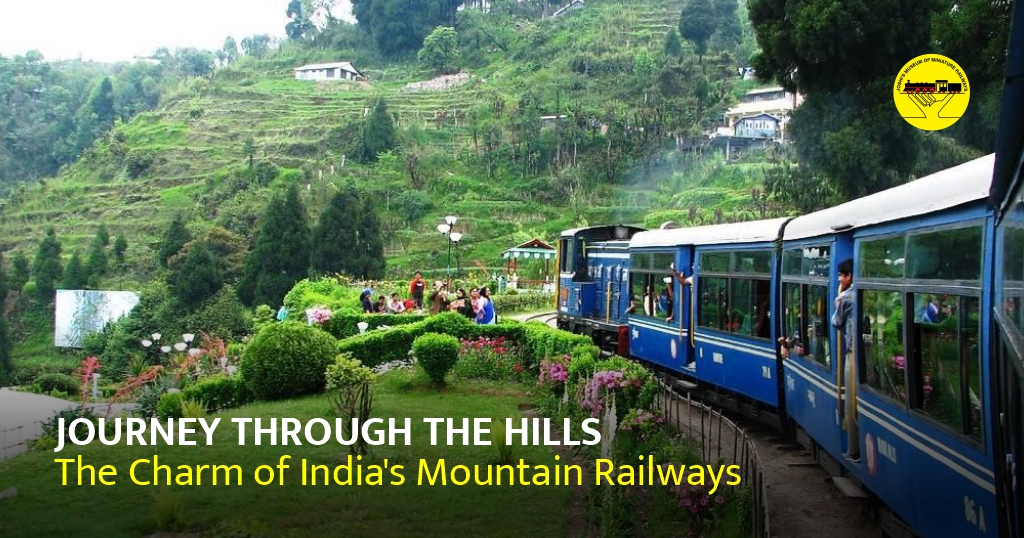

India’s mountain railways are not just a mode of transport- they are time machines wrapped in steel and steam, taking passengers through breathtaking landscapes, dense forests, and charming colonial towns.
Nestled in the lap of the Himalayas and the Western Ghats, these engineering marvels carry stories of ambition, perseverance, and an undying love for the hills.
Whether you’re a rail enthusiast, a nature lover, or a history buff, a journey on these heritage tracks is an experience like no other.
The Indian Railways has quite an extensive history, and India’s mountain railways trace their origins back to the British colonial era, built primarily to access hill stations that offered respite from the summer heat.
Over the years, three of these railways- the Darjeeling Himalayan Railway, Nilgiri Mountain Railway, and Kalka-Shimla Railway– have been inscribed as UNESCO World Heritage Sites under the collective title Mountain Railways of India.
Each one is a testament to brilliant engineering, offering an unforgettable passage through some of the most scenic parts of the country.
Let’s explore these iconic railways and what makes them so magical.
Route: New Jalpaiguri to Darjeeling
Length: 88 km
UNESCO Status: Declared in 1999
Fondly known as the “Toy Train,” the Darjeeling Himalayan Railway is one of India’s most iconic rail experiences. The train climbs from the plains of Siliguri to the breezy heights of Darjeeling, winding through tea gardens, pine forests, and misty hills.
Whether it’s the rhythmic chug of the engine or the laughter of children waving at the train, every moment on the DHR feels like a scene from an old postcard.
Route: Mettupalayam to Udhagamandalam (Ooty)
Length: 46 km
UNESCO Status: Added in 2005
The Nilgiri Mountain Railway is the steepest track in Asia and the only one in India that uses a unique rack-and-pinion system to climb the slopes. Built in 1908, this railway snakes through the Nilgiri Hills of Tamil Nadu, popularly known as the Blue Mountains.
This rail journey is slow, charming, and absolutely spellbinding- perfect for those who want to soak in every bit of nature’s beauty.
Route: Kalka to Shimla
Length: 96 km
UNESCO Status: Added in 2008
This narrow-gauge railway is a marvel of colonial engineering, connecting the plains of Haryana with the hills of Himachal Pradesh. Shimla, once the summer capital of British India, owes much of its accessibility to this railway, which was inaugurated in 1903.
Especially during winter, when snow caps the landscape, this train ride turns into a dreamy fairytale route.
While the above three railways have achieved UNESCO fame, there are other hill trains that deserve mention:
Route: Neral to Matheran, Maharashtra
Length: 20 km
Charming Aspect: Matheran is Asia’s only automobile-free hill station, and this railway is the only way to reach it besides hiking. The train ride offers hairpin bends and cliff-hugging tracks with panoramic views.
Route: Pathankot to Joginder Nagar, Himachal Pradesh
Length: 164 km
Unique Feature: It’s the longest mountain railway in India and provides stunning views of the Dhauladhar Range and Kangra Valley.
Constructing rail lines through steep gradients, dense forests, and treacherous terrains over a century ago was nothing short of miraculous. From spiral loops to zig-zag reverses and hairpin bends, these railways pushed the boundaries of civil engineering.
Each railway tells a story of the region- its people, customs, and colonial past. The quaint stations, with their tin roofs and vintage signboards, transport travelers to a different era.
These heritage lines are vital to tourism, bringing thousands of travelers to the hills every year. They provide local employment, sustain hill economies, and promote eco-friendly travel.
In today’s fast-paced world, these mountain trains champion the art of slow travel. They encourage passengers to pause, look around, and appreciate the journey rather than just the destination.
The Indian Railways is taking steps to preserve and modernize these heritage lines without losing their charm. New initiatives include:
Sustainability is also a key focus. Steps like waste management, eco-toilets, and renewable energy at stations are being introduced to ensure that these pristine regions stay untouched.
India’s mountain railways are more than just relics of the past- they’re living, breathing journeys that connect people to places and emotions.
They offer a window into the soul of the hills- where time slows down, the air smells of pine, and the rhythmic clatter of wheels soothes the spirit.
Whether you’re meandering through the mists of Darjeeling, climbing the blue hills to Ooty, or curling through the pine-clad slopes to Shimla, these journeys offer memories for a lifetime.
So the next time wanderlust calls, skip the flights. Hop aboard a mountain train. Let India’s hills whisper their secrets through the clinking carriages and winding tracks. Trust us- it’s not just a ride. It’s a soulful journey through the clouds.
1. What is the best time to travel on India’s mountain railways?
The best seasons are spring (March to May) and autumn (September to November) for clear skies and pleasant weather. Winter journeys on the Kalka-Shimla route are also popular due to snowfall.
2. Are these trains safe for solo travelers and families?
Yes, they are considered safe. The coaches are usually full of tourists and local travelers, and the pace of travel is relaxed.
3. How can I book tickets for these trains?
Tickets can be booked via the IRCTC website or app. During peak seasons, it’s best to book at least a month in advance.
4. Are there food options available on the train?
Some hill trains may have light snacks or vendors at stations. It’s best to carry your own food and water.
5. Can I take pets on board mountain trains?
Pets are generally not allowed in passenger coaches, but rules may vary. It’s best to check with Indian Railways before booking.